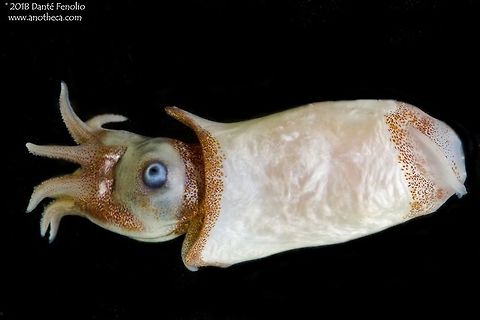
Appearance
''S. spirula'' has a squid-like body between 35 mm and 45 mm long. It is a decapod, with eight arms and two longer tentacles, all with suckers. The arms and tentacles can all be withdrawn completely into the mantle.The species lacks a radula:110:26 .
Distribution
By day, ''Spirula'' lives in the deep oceans, reaching depths of 1,000 m. At night, it rises to 100 to 300 m. Its preferred temperature is around 10 °C, and it tends to live around oceanic islands, near the continental shelf.Most sources cite this species as tropical, and they are observed to be plentiful in the subtropical seas around the Canary Islands. Shells are regularly found along the western coasts of South Africa. However, significant quantities of shells from dead spirula are washed ashore even in temperate regions, such as coasts of New Zealand. Because of the great buoyancy of the shells, these may possibly have been carried long distances by ocean currents.
Much of the organism's life history has not been observed; for instance, they are thought to spawn in winter in deeper water, yet no spawnlings have been directly seen. They must occasionally venture into the upper 10 m of the sea, for they are sometimes found in albatross guts.
Behavior
''S. spirula'' is capable of emitting a green light from a photophore located at the tip of its mantle, between the ear-shaped fins.Habitat
By day, ''Spirula'' lives in the deep oceans, reaching depths of 1,000 m. At night, it rises to 100 to 300 m. Its preferred temperature is around 10 °C, and it tends to live around oceanic islands, near the continental shelf.Most sources cite this species as tropical, and they are observed to be plentiful in the subtropical seas around the Canary Islands. Shells are regularly found along the western coasts of South Africa. However, significant quantities of shells from dead spirula are washed ashore even in temperate regions, such as coasts of New Zealand. Because of the great buoyancy of the shells, these may possibly have been carried long distances by ocean currents.
Much of the organism's life history has not been observed; for instance, they are thought to spawn in winter in deeper water, yet no spawnlings have been directly seen. They must occasionally venture into the upper 10 m of the sea, for they are sometimes found in albatross guts.
Evolution
The order Spirulida also contains two extinct suborders: Groenlandibelina , and Belopterina .''Spirula'' is likely the closest living relative of the extinct belemnites and aulacocerids. These three groups as a unit are closely related to the cuttlefish, as well as to the true squids.
References:
Some text fragments are auto parsed from Wikipedia.